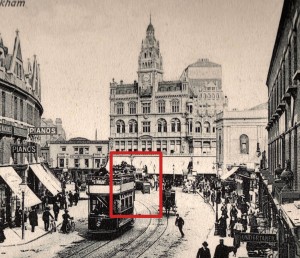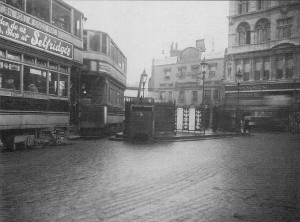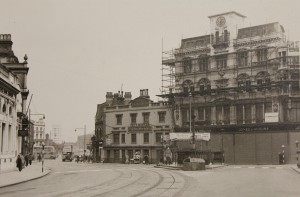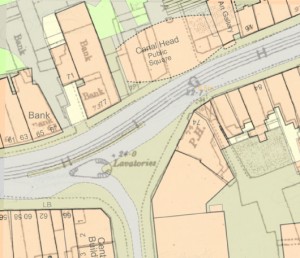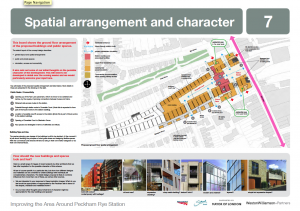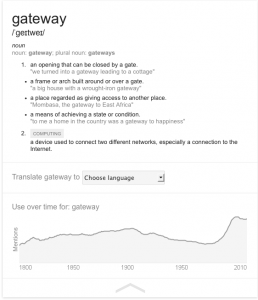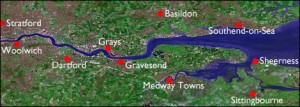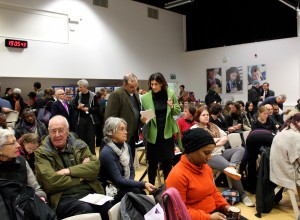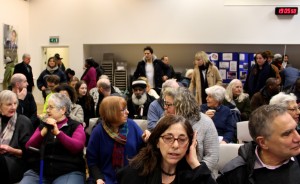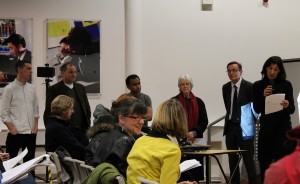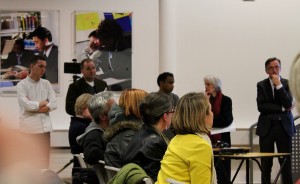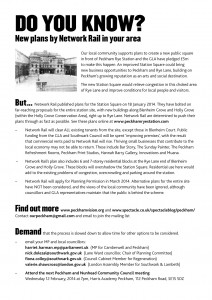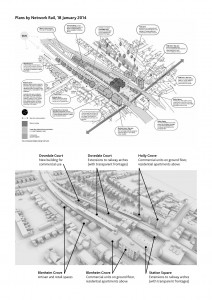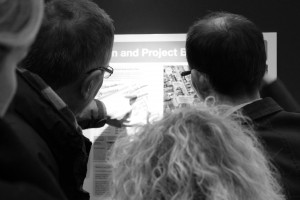
In 2012, the Mayor of London, Boris Johnson, made available funds from The Greater London Authority (GLA), designed for the regeneration of some of the capital’s boroughs and £177 million was set aside for generally “boosting local high streets, delivering growth and new jobs and improving lives”. Within this budget a £70 million Regeneration Fund was put into action following the 2011 Summer Riots, presumably in an attempt at ‘damage-control’ of the worst affected areas. Peckham came under this title. The borough of Southwark was awarded £5.2 million by the GLA fund for the purpose of the redevelopment of Peckham Rye Station and the Gateway Area, for “new and improved commercial/retail spaces respectively and nearly 100 new jobs“.
The GLA has a very specific policy on transparency and openness, its guidelines on the subject can be found here. They aim to provide information as to how they operate, publish decisions and governance arrangements, and free up the data that they hold. However, a very specific document – the Agreement for the Provision of Funding Relating to the London Borough of Southwark Gateway to Peckham Project between GLA and The Mayor and Burgesses of the London borough of Southwark – was unpublished and untraceable. Eileen Conn, of Peckham Vision, administered a Freedom of Information request to Southwark Council in early August 2013 for the document. She received only a redacted hard copy with print so small that much of the document was illegible. Southwark Council gave the excuse that the 74 page PDF document was too large to be sent via email (questionable in itself). On the 4th October 2013, Eileen issued another request for a digital version, which was only fulfilled on the final day of the statuary 20 day target. The full PDF can be found lurking suspiciously in the GLA disclosure log; very much not accessible or transparent. The whole scenario contradicts their intended policy “to help Londoners hold us to account”.
The Agreement embodies some interesting project objectives regarding the purpose of the redevelopment plan and the aims the Mayor’s fund intends to achieve; dated, signed and sealed by Executive Director of Resources, Martin Clarke, himself. The objectives are detailed and discussed below:
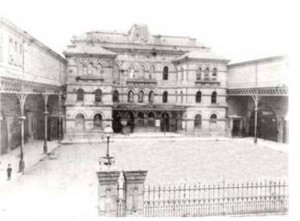
“Increase accessibility to the town centre by improving Peckham Rye station and reinstating a high quality public realm which incorporates active uses and reconnects the station with the high street”
This objective refers to the plans for the square to be reintroduced in front of Peckham Rye station, as it was in 1880. The initial plans, drawn up by Network Rail in response to a campaign by Peckham Vision, were well received and the subject of much excitement for members of the community. Despite much recent contention surrounding the expansion of the project to other areas (see our blog reporting on the public consultation meeting), the plans for a public realm (page 8) reconnecting the station with Rye Lane remain a singularly, positive aspect of the Gateway Project.
The second aim however…
“Draw new visitors to the high street to deliver economic benefits to local business including increased retail activity and footfall by providing high quality accommodation for active uses and evening economic activity”
In fact, increased retail activity and footfall has already been observed in Peckham over the last year, it being described as London’s newest “hotspot“, and people are already drawn to the area from all over town for various reasons (see our previous blog on the matter). This apparent need to fix things that are not broken is a commonality of the Agreement and Network Rail’s plans on the whole.
The description of the project activities on page 26 also details how the railway arches will be “transformed” for galleries and studios, which will support the local economy and create new jobs. The fact that all of this money is being spent on spaces that are already occupied in the trades they are trying to attract suggests either there is dishonesty or stupidity at play.
Regardless, no economic benefits will be felt by the local businesses of the Gateway Area, who are all being evicted from their premises to be replaced by “high quality accommodation”. This inevitable increase in rental value will only benefit Network Rail and will attract only the likes of Costa and M&S, who can afford such spaces. This type of corporate industry will eventually destroy the rest of Rye Lane’s independent, family-run business economy by jacking up Peckham’s rent prices, as was sadly seen in Borough Market and Clapham.
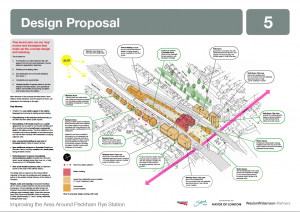
“Creating new jobs in the town centre”
Despite that fact that numerous current jobs are to be lost on account of these plans, new jobs will indeed be made available. However, the types of jobs created will not be ones open to much progression: ‘McJobs’. By putting in retail and commercial spaces,employment opportunities in the area are limited to shop assistants, baristas and cashiers etc. Yet the jobs lost are already ones with potential for real growth and career prospects for members of the community. Apprentices, graduates and interns alike, have passed through and beyond the Arches of Peckham, yet the new businesses are likely to flatten inspiration and aspiration.
“Bring diverse communities together to enjoy and connect with their high street and the town centre, providing a focus for community uses, socializing and events”
It is almost as if the person that wrote this objective has never even stepped foot on soil south or east of Harvey Nichs, let alone in Peckham. It is a struggle to imagine how much closer ‘diverse communities’ can be brought than as they stand on Rye Lane; Khans is largely run by Pakistanis, Afro-Caribbean barbers and hairdressers line the streets, Il Giardinio on Blenheim Grove is owned by Sardinians, and there are Irish butchers and Irish-run Canavan’s Pool Club, to name a few.
As Peckham Vision have demonstrated in their hotspot map below, many of the creative enterprises in the town centre rely on an interconnected, relationship-based infrastructure, that could not be restored by relocation. A fact that seems to be entirely overlooked by Network Rail, and one that can apparently be magically created by GLA through the use of “milestones”.
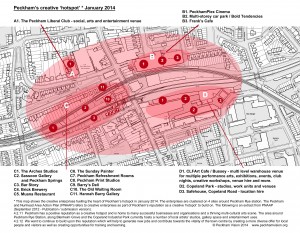
“Continue engagement with the local community and bringing out what is unique about Peckham, creating character and vibrancy, and restoring and celebrating some of the high street’s historic character”
What is unique about Peckham, as discussed here, is not the same type of uniqueness that can be seen in the ‘Shorditchification of London‘. Artisan businesses have been nurtured for decades; character and vibrancy have long since been instated here. It makes no sense that a huge corporation could ever hope to instil such qualities in a place.
The emphasis and importance of appearance resonates throughout the paper, the GLA even cite evidence of correlations of quality street design and increased retail rents! These Mary Portas-style rejuvenation ideas can be observed under the ‘Town Centre Design Guide’, which proposes it will “encourage all owners of buildings in the town centre to improve the design of their shop fronts and building frontages” (page 27). Similarly, the discussion in Schedule 5 (page 45) of the “perception of crime” in the area, without factual investigation or crime statistics, and as a reason for the urban planning decisions, bases yet more on weight on aesthetics, rather than actual economic success.
“Attract private sector investment to key development sites in Peckham’s town centre and raise aspirations for design quality in the town centre, setting the standard for future developments and public realm projects.”
Attracting private sector investment into Peckham provides absolutely no community or local economic benefits whatsoever. As stated before, the only beneficiaries will be Network Rail who are hoping to improve upon their £6.2 billion revenue (2013). It also entirely contradicts all the previous statements of intent. What makes Peckham unique is it’s sprawling diversity, it’s independent, local business culture, and it’s recent creative economic boom. By inviting big-wig investors to lay their hands on unarguably the best sites in Peckham, it will become yet another mono-cultural section of London – destroyed from the inside out.
The small and medium-sized enterprises (SME’s) and cultural industries that make up Peckham’s existing economy – not limited to the Gateway Area, but the whole of the town centre – are dependent on low rents. By incurring vast expenditures on redevelopment projects, a revenue can only be brought back through increased rents, forcing out anyone currently residing in Peckham because of the lower prices.
A similar redevelopment struggle was seen at Twickenham Station a couple of years ago. Sadly, not enough could be done to save it in the anticipation for the 2015 Rugby World Cup, but there is still hope for Peckham yet. The entire plan must be rejected, because a compromise on any of the factors will mean a huge community and local industry sacrifice.

The questions intended to be raised here are:
Should the GLA fund, which is partly subsidised by council tax, be funding a project that will only financially benefit a huge corporation, Network Rail?
Not only that, but should the GLA be financing a project that is likely to severely damage much of the independent, local economy as it is?
Additionally, was the GLA in breach of its own transparency and openness policy in not providing the Agreement document, and only providing an online PDF version after 4 months and two Freedom of Information requests?
Please feel free to leave your comments below in answer to these questions or any other statements throughout the blog.
Get in touch if you would like to contribute to our film about the Peckham Rye Station and Gateway Area Redevelopment Project. Just email production@spectacle.co.uk
See Peckham for more blogs and information.
Or visit PlanA, our general blog on urbanism, planning and architecture.
Spectacle homepage
Like Spectacle Documentaries on Facebook
Follow SpectacleMedia on Twitter

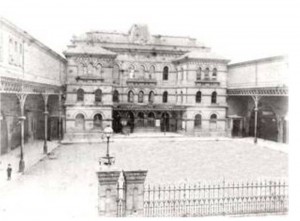



 Network Rail Winter Newsletter 2012
Network Rail Winter Newsletter 2012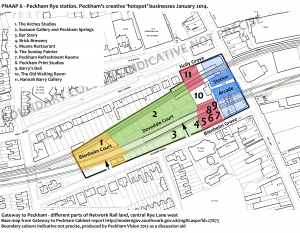
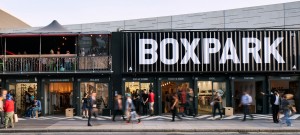 Peckham Peculiar
Peckham Peculiar